语言学第二章讲课讲稿
- 格式:doc
- 大小:77.01 KB
- 文档页数:10

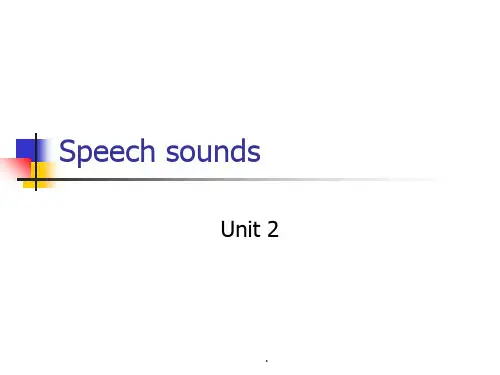


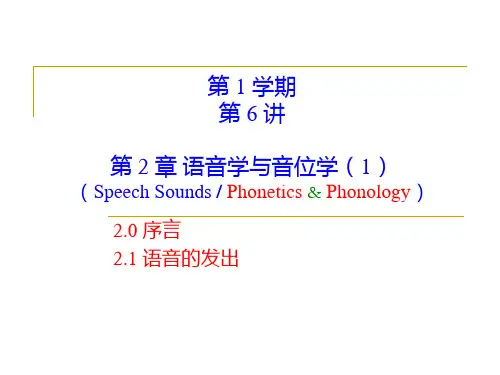
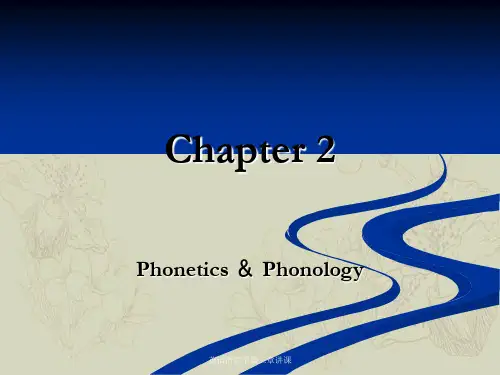
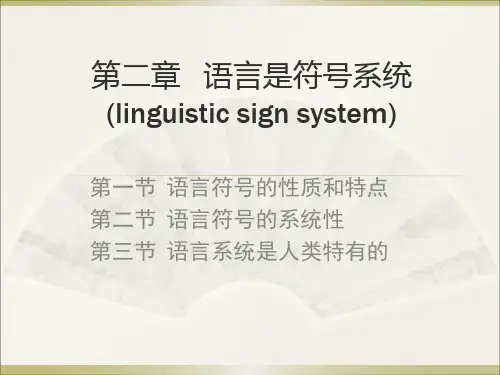
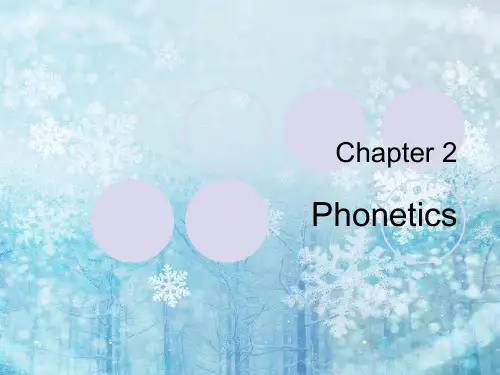


语言学第二章练习题Chapter 2 Phonology1. What are the two major media of communication? Of the two, which one is primary and why?Two major media of communication are speech and writing, Of the two, speech is primary. The reasons are as follows.1)From the point of view of linguistic evolution, speech is prior to writing. Thewriting system of any language is always “invented’ by its users to recordspeech when the need arises.2)In everyday communication, speech plays a greater role than writing in termsof the amount of information conveyed.3)Speech is always the way in which every native speaker acquires his mothertongue, and writing is learned and taught later when he goes to school.4)For modern linguists, spoken language reveals more true features of humanspeech while written language is only the “revised” record of speech.2. What is voicing and how is it caused?Voicing is a quality of speech sounds. It is caused by the vibration of the vocal cords.3. Explain with examples how broad transcription and narrow transcription differ.When we use a simple set of symbols in our transcription, it is called broad transcription. Narrow transcription is the use of more specific symbols to show phonetic details.In broad transcription, the symbol [ l ] is used for the sound [ l ] in words leaf [ li:f] and feel [fi:l]. The [l] in [ li:f] , occurring before a vowel, is called clear [ l ]. The [ l ] in [fi:l] occurring in the end of a word or before another consonant , is called dark [ l ].And in narrow transcription the diacritic tilde [~] is used to indicate it. 4.How are the English consonants classified?English consonants can be classified in two ways: one is in terms of manner of articulation and the other is in terms of place of articulation.In terms of manner of articulation, it can be classified into stops, fricatives, affricates, liquids, glides and nasals. In terms of place of articulation, it can be classified into bilabial, labiodental, dental, alveolar, palatal, velar and glottal.5. What criteria are used to classify the English vowels?According to the place of the tongue, vowels can be distinguished as front, central and back. According to the openness of the mouth, vowels can be classified into four groups: close vowels, semi-close vowels., semi-open vowels and open vowels. According to the shape of the lips, all the front vowels and the central vowel can are unrounded vowels and all the back vowels are rounded vowels.6. Give the phonetic symbol for each of the following sound descriptions:1) voiced palatal affricative [ dʒ ]2) voiceless labiodental fricative [f ]3) voiced alveolar stop [ g ]4) front close short [ i ]5) back semi-open long [ ɔ: ]6) voiceless bilabial stop [ p ]Give the phonetic features of each of the following sounds1)[ d ] voiced alveolar stop2)[ l ] voiced alveolar liquid3)[ tʃ ] voiceless palatal affricate4)[ w ] voiced bilabial glide5)[ u ] back close short6)[ ae ] front open7. How do phonetics and phonology differ in their focus of study? Who do you think will be more interested in the difference between, say, clear [ l ] and dark [ l ] , aspirated [ p] and unaspirated [p] , a phonetician or a phonologist ? why? Phonology and phonetics differ in their approach and focus. Phonology aims at discover how speech sounds in a language form patterns and how these sounds are used to convey meaning in linguistic communication. Phonetics is of a general nature and it is interested in all the speech sounds used in all human languages.The difference between clear [l] and dark [ l ] is what the phoneticians are interested in . For the phonologists, these two sounds are fundamentally the same ,since they have one and the same function in communication , in distinguishing between words and meanings despite their difference in pronunciation.8. What is a phone? How is it different from a phoneme? How are allophones related to a phoneme?A phone is a phonetic unit or segment. A phoneme is a phonological unit. It is a unit that is distinctive , abstract and it is the smallest unit. The different phones which can represent a phoneme in different phonetic environments are called the allophones of that phoneme. For example, in the word leaf [ li:f] and the word deal [di:l] , / l / is onephoneme and the [l] in [li:f] is clear, the [ l ] in [di:l] is dark. They are all allophones of the phoneme /l/.9. Explain with examples the sequential rule, the assimilation rule, and the deletion rule.Sequential rules are the rules that govern the combination of sounds in a particular language. For example, if a word begins with a [ l ] or [ i ], then the next sound must be a vowel. Thus, [ lbik ] [ ilkb ] are impossible in English. They have violated the restrictions on the sequencing of phonemesThe assimilation rule assimilates one sound to another by “copying’ a feature of a sequential phoneme, thus making the two phones similar. For example, the [ i:] sound is nasalized in words like bean, green and team. This is because in all these sound combination the [ i:] sound is followed by a nasal [n ] or [ m].The deletion rule tells us when a sound is to be deleted although it is orthographically represented. For example, in the pronunciation of such words sign, design, there is no [ g ] sound although it is represented in spelling by the letter g10. What are the suprasegmental features ? How do the major suprasegmental features of English function in conveying meaning?The phonemic features that occur above the level of the segments are called suprasegmental features. The main suprasemental features include stress, intonation and tone. The location of stress in English distinguishes meaning. Tones are pitch variations, which are caused by the differing rates of vibration of vocal cords. Intonation plays an important role in the conveyance of meaning in almost every language, especially in a language like English. Intonation has four tones.: the falling tone, the rising tone, the fall-rise tone, the rise-fall tone. When spoken in different tones, the same sequence of words may have different meanings.杨晓娅唐明李克燕谢江兰李佳卉2011级英语二班。
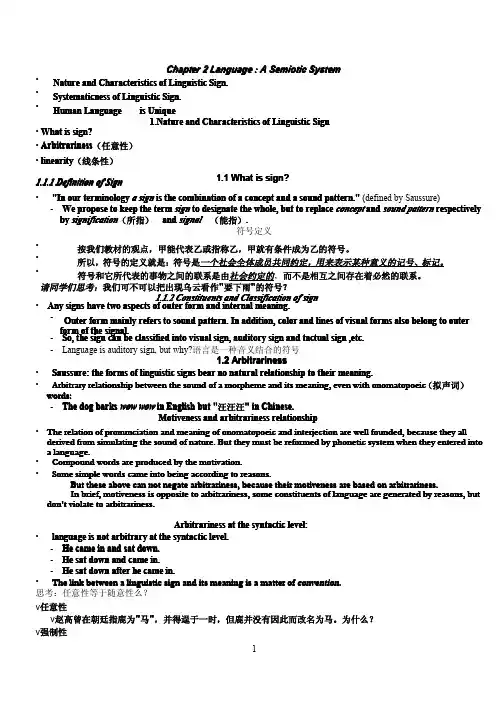
英语语言学第二章讲课课件一、教学内容本节课我们将学习英语语言学第二章,主要内容包括:语系与语言分类、语音学与音系学基础、以及词汇学初步。
具体涉及教材第二章的13节,重点探讨语言的起源、语言如何通过语音和词汇表达意义,以及不同语言之间的相似与差异。
二、教学目标1. 理解世界主要语系的特点及其分类依据,能列举至少三种语系并说明其代表性语言。
2. 掌握语音学基本概念,识别不同语音特征,并能在实际语境中进行应用。
3. 运用词汇学知识分析词语构成,提高词汇理解和运用能力。
三、教学难点与重点重点:语音学基本概念、词汇学的主要理论。
难点:语音的发音规则、词汇在不同语境中的应用。
四、教具与学具准备教具:PPT展示、录音机、语音示例CD。
学具:笔记本、词典、语音学基础教材。
五、教学过程1. 导入(5分钟):通过展示世界地图,引入不同地区语言的多样性,激发学生对语言起源和分类的兴趣。
2. 理论讲解(20分钟):介绍语系分类、语音学基础和词汇学构成,结合教材第二章13节内容。
3. 实践情景引入(10分钟):播放不同语言的问候语录音,让学生体验语言差异。
4. 例题讲解(15分钟):讲解语音学中元音、辅音的分类及发音规则,通过例词进行示范。
5. 随堂练习(10分钟):分组进行语音模仿和词汇构造练习。
六、板书设计1. 语系与语言分类印欧语系汉藏语系阿尔泰语系2. 语音学基础元音与辅音发音规则3. 词汇学初步词根、词缀词语构成七、作业设计beautifulunderstand2. 答案:beautiful: beauty, beautifully, beastunderstand: understanding, understandable, misunderstand八、课后反思及拓展延伸1. 反思:关注学生在课堂上的参与度,针对语音模仿环节进行教学调整,提高学生的发音准确性。
2. 拓展延伸:鼓励学生课下阅读更多关于语音学和词汇学的资料,了解语言的发展趋势及其背后的文化因素。
第二章音系学1.语言的声音媒介语言的形式有声音和文字。
在这两种媒介中,声音是语言最基本的媒介,是第一性的。
这是因为在语言的发展过程中,声音媒介早于文字。
文字是对声音的记录。
在日常交际中,大量信息是通过口头交际来完成的,只有在无法进行口头交际的情况下人们才使用文字形式。
除此之外,人们是通过声音媒介来习得自己的母语的。
2. 语音学2.1什么是语音学语音学研究的对象是语言的声音媒介,即人类语言中使用的全部语音。
语音学有三个分支:发声语音学、听觉语音学和声学语音学。
它们各有自己的侧重点但又互有联系。
发声语音学主要研究语言使用者是如何使用发音器官发出语音,并对所发出的音进行分类。
听觉语音学主要是从受话人的角度来研究语音,即语音是如何被受话人感知和理解的。
声学语音学主要研究语音的物理特性。
通过对语音声波的研究,声学语音学家得出了一些重要的结论。
最为重要的结论,所说出的这些通常被认为是同一个话语,如果从声音的物理特性上去分析,其实它们的声波并不相同,只是由于它们之间存在的差异太小,是人耳所不能辨别的。
如果它们的声波相同,这只是一种巧合。
因此,语音的等同只是一种理论上的理想。
2.2发音器官人类的发音器官存在于咽腔、口腔和鼻腔腔内。
咽腔内最重要的发音器官是位于喉头的声带,发音时声带在气流的冲击下发生颤动决定了声音的浊音化(voicing)。
浊音化是所有元音以及部分辅音,如[b],[g],[m]等所具有的特性。
声带不发生颤动所发出的音是清音,如[t],[k],[f]等。
声带颤动的频率决定了声音的高低。
口腔中发音器官最多,有舌头、小舌、软腭、硬腭、齿龈隆骨、牙齿和嘴唇。
其中舌头是最灵活、最重要的发音器官。
发音时,来自肺部的气流在口腔中受到不同的阻碍,从而发出不同的音。
鼻腔和口腔相通。
发音时软腭后移关闭鼻腔,气流只能从口腔通过,所发出的音没有鼻音化。
但当鼻腔通道打开,允许气流从鼻腔通过,所发出来的音便是鼻音。
2.3音标——宽式和严式标音法音标是在国际上被广为接受的一套对语音进行标音的标准符号体系。
标音分为宽式和严式标音法。
宽式标音法是用一个符号来表示一个语音的标音方式。
严式标音法是一种使用变音符号的标音方式,旨在记录同一个音在不同的语音环境下所发生的细微的变化,如在star 和tar中的/t/的发音就不一样,前者/t/是不送气音,后者/t/是送气音。
这些细微区别只有通过严式标音法才能表示。
2.4英语语音的分类英语中的语音根据气流的受阻情况分为元音和辅音。
气流没有受到任何阻碍所发出的音是元音;气流在口腔里受到不同方式的阻碍所发出的音是辅音。
2.4.1英语辅音的分类根据发音方式,英语的辅音可以分为:1)爆破音:发爆破音时,气流开始完全受阻,然后突然释放,如[p],[b],[t],[d],[k],[g]2)摩擦音:发摩擦音时,气流部分受阻,气流从狭窄的通道挤出,产生摩擦,如[f],[v],[s],[z],[ θ],[ T ], [∫], [ V ], [h]3)塞擦音:发塞擦音时,气流开始完全受阻,然后气流从狭窄通道缓慢释放,并伴有摩擦发生,如:[t∫], [dV ]4)流音:在发流音时,受阻的气流从舌头与上部(roof of the mouth)形成的通道释放出,如:[l],[r]。
5)鼻音:发音时,气流从鼻腔释放出所发出的音为鼻音,如[n],[m],[N ]6)滑音:滑音又称之为半元音。
英语中滑音有[w]和[j]。
它们的发音方式与[u]和[i]相同。
根据发音部位,英语辅音可以分为:1)双唇音:气流受阻部位在双唇,如[p],[b],[m],[w]2)唇齿音:下唇与上齿接触使气流受阻,如[f],[v]3)齿音:舌尖与上齿接触使气流受阻,如:[θ],[ T]4)齿龈音:舌尖与上齿龈隆骨接触使气流受阻,如:[t],[d],[s],[z],[n],[l],[r]5)腭音:受阻部位发生在舌根与硬腭之间,如:[∫], [ V],[ t∫], [dV ], [j]6)软腭音:舌根与软腭接触使气流受阻,如:[k], [g], [ N ]7)喉音:声带短时接触使气流受阻,如:[h]元音与辅音不同,不能根据辅音的发音方式和发音部位来分类。
元音常根据舌位的高低、开口度、嘴唇形状、元音的长度和发音时喉部的紧张程度来分类。
1)舌位的高低发音时,舌头前部抬得最高的音为前元音,通常有:[i:] [i] [e] [A] [a].发音时,舌头的中部抬得最高为中元音,如:[\:], [[],[Q]发音时,舌根部位抬得最高为后元音,如:[u:] [J] [ C:], [ ]and [B:].2)开口度:根据开口度,通常把元音分为以下四种:闭元音:如:[i:],[ i],[u:],[J]半闭元音:如:[e], [з: ]半开元音:如[ [ ], [ C: ]开元音:如:[?], [a], [Λ], [ ], [ɑ:]3)嘴唇形状:圆唇元音:英语中除了[ɑ:]以外,所有的后元音都是圆唇元音。
不圆唇元音:英语中所有的前元音和中元音都是不圆唇元音。
4)元音的长度:根据发音的长度,元音分为长元音和短元音。
长元音常用一个分号来表示。
英语中长元音有:[i:] [\:] [ C: ] [u:] [ɑ:],其余都是短元音。
5)根据发音时喉部的紧张程度把元音分为紧元音和松元音。
6)除了单元音外,英语中还有一组双元音,如:[ ei ] [ai] [Eu] [aJ ] [Ci ] [iE] [eE] [JE]。
根据以上标准,我们可以对元音进行描述,如[e]被描述为前、半闭合、不圆唇元音。
3.音系学3.1音系学和语音学音系学和语音学都是对语音的研究,它们有联系但又有区别。
语音学研究对象是人类所有语言的语音,它主要是对语音进行描述和分类,如,音的发音方式,音的语音特征,以及音与音之间的差别;音系学研究的是某一特定语言的语音体系,即音在特定的语言中是如何结合产生有意义的单位来进行交际。
音系学家不关注不具备语义区别性价值的语音,而语音学家既研究具有语义区别性价值的音,也研究不具备语义区别性价值的音。
3.2音素、音位、音位变体音素是语音学研究的单位。
人类在说语言时所发出的一切音都是音素(phone),有些音素具有语义区别性价值,有些音素没有。
如:在单词feel[fi:?], leaf[li:f], tar[tha:], star[sta:]中,一共有7个音素,分别是[f],[i:],[?], [l], [th]. [t], [a:]。
音系学研究的基本单位是音位,音位具有区别性价值,音位是抽象的,是一组语音特征的集合,它不是一个具体的音。
一个音位会在不同的语音环境中实现为具体的音,如音位/p/在语境中可实现为具体的送气和不送气音等,这种语音的细微差别可在单词spade和pay中的/p/的发音可以看出。
音位在特定的语音环境里的具体体现形成音位变体,同一个音位在不同的语音环境里体现为不同的变体称之为音位变体如,音位/t/在star和tar中分别实现为不送气[t]和送气[th],因此不送气[t]和送气[th]为音位/t/的音位变体。
3.3音位对立、互补分布.最小对立对如果两个音位可以出现在相同的语音环境中,且具有区别语义的功能,那么它们就形成了音位对立。
如tip和dip中的/t/和/d/占据了相同的语音位置,且具有区分语义的价值,因此/t/和/d/形成音位对立。
互补分布体现的是同一音位不同音位变体之间的关系。
如果在语音上相似的两个音不能出现在相同的位置上,且没有区别意义的功能,那么它们之间的关系就是互补分布关系。
如top中送气的[th]和stop中不送气的[t]的关系是互补关系,如果把stop中的[t]发成了送气音并不影响语义。
最小对立对指的是两个语音群(通常是单词)中的语音除了一个音不同,且不同的音处在相同的位置上,其余的成分完全相同,因此这两个语音群形成最小对立对。
如tip和dip形成最小对立对,其中/-ip/完全相同,只有第一个音不同。
构成最小对立对的还有/pig/和/dig/;/pen/和/ben/;/robe/和/rote/等,但是/tip/和/pit/,/mop//opt/不构成最小对立对。
3.4几条音系规则音系规则因语言的不同而不同,适用于一种语言的音系规则未必适用于另一种语言。
3.4.1序列规则:序列规则是关于音与音之间的结合规则。
例如,在英语中,如果一个单词是以[l]或[r]为首音的话,那么后边紧跟的音必须是元音。
英语中的三辅音连缀需遵守以下序列规则:1.第一个音位必须是:/s/2. 第二个音位必须是:/p/ 或/t/或/k/3. 第三个音位必须是:/l/ 或/r/ 或/w/3.4.2同化规则:由于两个邻近的音相互影响使得两个音的发音出现类似现象,称之为同化。
同化现象遵循一定规则即同化规则。
英语中,鼻音化并不具有语义区别性特征,但是这并等于说,英语中元音没有鼻音化现象。
以元音[i:]为例,当它后面紧跟[n]或[m]时,会出现[i:]的鼻音化现象,这也成了英语同化规则之一。
再以齿龈音[n]为例,它的发音常受到后面辅音的影响。
当它后面紧接齿龈音时,[n]的发音是齿龈鼻音,如indirect [indi’rekt],但是当[n]后面紧接软腭音[k]时,[n]会发生同化现象变为齿龈鼻音[?],如incorrect[i?kE’rekt]。
声音的同化在拼写中可以得到体现。
如[n]后接双唇音时会同化为[m],这一同化现象使得possible的否定形式变成impossible, 而不是inpossible。
/in-/在以下单词中的不同的拼写如/ir-/和/il-/等都是[n]与后边音同化的结果,如illegal, irregular等。
当然也有一些音虽然发生了同化,但是并没有在拼写中体现出来。
如input中的[n]虽然受到[p]的同化发生音变,但是这种音变并没有体现在拼写之中。
3.4.3省略规则省略规则是指导一个音在什么语音语境下可以不发音的原则。
英语中的一个省略原则是:当一个单词以鼻音结尾,而在这个鼻音前存在一个[g],那么这个[g]不发音,如sign, design, paradigm等,当这些单词的鼻音后边又跟上其它后缀时,[g]要发音,如signature, designation, paradigmatic等。
3.5 超切分特征音位的区别性特征可以跨越两个或两个以上的音位成分。
超切分特征指超过话语中一个以上的语音的特征。
常见的超切分特征有重音、声调和语调。
对英语来说重要的是重音和语调。
声调是声调语言如汉语重要的超切分特征。
3.5.1重音重音可以分为词重音和句重音。
说话时在发某个或某几个音时所花力气比发其它音时要大,因此造成说话中的重音。